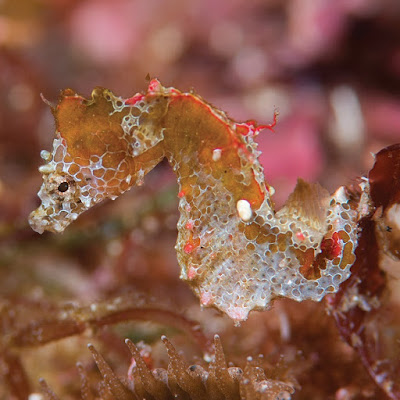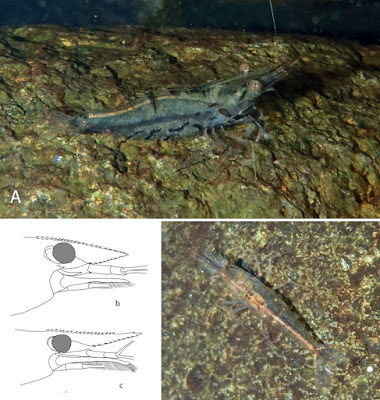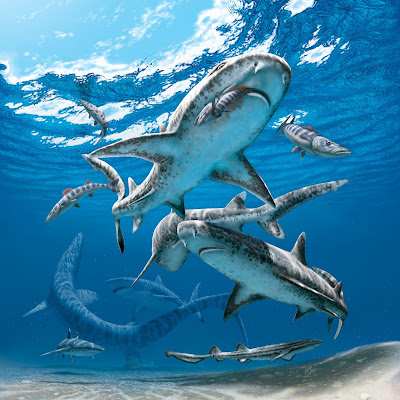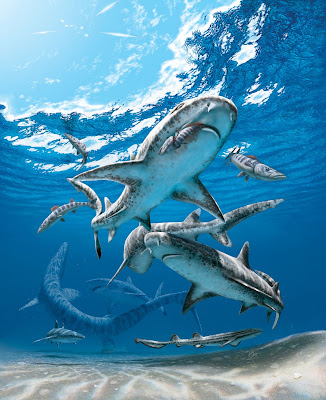[Most Recent Entries] [Calendar View]
Monday, August 6th, 2018
| Time | Event | ||||||||
| 1:32a | [Ichthyology • 2018] Hippocampus japapigu • A New Species of Pygmy Seahorse (Teleostei, Syngnathidae) from Japan, with A Redescription of H. pontohi
Abstract The pygmy seahorse Hippocampus japapigu sp. n. is described based on three specimens, 13.9–16.3 mm SL, collected from a mixed soft coral and algae reef at 11 m depth at Hachijo-jima Island, Izu Islands, Japan. The new taxon shares morphological synapomorphies with the previously described central Indo-Pacific pygmy seahorses, H. colemani, H. pontohi, H. satomiae, and H. waleananus, including extremely small size, 12 trunk rings, strongly raised continuous cleithral ring, snout spine, large spine on the eighth lateral and fifth and 12 superior trunk ridges, respectively, and unusual wing-like-protrusions immediately posterior to the head. Hippocampus japapigu sp. n. can be distinguished from all congeners by the following combination of features in the anterodorsal area of the trunk: bilaterally paired wing-like protrusions formed by a single pair of large, truncate spines projecting dorsolaterad on the first superior trunk ridge, followed by a unique elevated dorsal ridge formed by triangular bony mounds dorsally on the second to fourth superior trunk ridges. In contrast, H. pontohi possesses a pair of large truncate spines projecting strongly laterad on both the first and second superior trunk ridges followed by flat surfaces dorsally on the third and fourth superior trunk rings. The new species can be further differentiated by genetic divergence from H. pontohi (an uncorrected p-distance of 10.1% in the mitochondrial COI gene) and a striking reticulated white and brown lattice pattern on the head, trunk, and tail. Hippocampus japapigu sp. n. represents the fifth species of pygmy seahorse recorded in Japan. Keywords: Acanthomorpha, computed tomography, reef fish, new species, systematics, taxonomy, computed tomography
Hippocampus japapigu sp. n. Diagnosis. Hippocampus japapigu sp. n. differs from its congeners by the following combination of characters: tail rings 28; dorsal fin rays 14; pectoral fin rays nine; subdorsal rings four; bilaterally paired wing-like protrusions formed by a pair of large truncate spines projecting laterad on first superior trunk ridge; elevated dorsal ridge formed by unique triangular bony mounds dorsally on second, third, and fourth trunk rings with the posterior mound less pronounced; large and prominent spine projecting laterad on eighth lateral trunk ridge.
Distribution and habitat: Hippocampus japapigu sp. n. is only known to occur in Japan, from scattered localities including Kashiwa-jima Island, Sukumo Bay; Kushimoto, Kii Peninsula; Osezaki, Izu Peninsula; the Izu Islands of Miyake and Hachijo; Sagami Bay; and Chichi-jima, Ogasawara Islands. The specimens described herein were found off the northwest coast of Hachijo-jima Island at a depth of 10–13 m, and have been anecdotally reported elsewhere at 5–22 m by local divers. Owing to its diminutive size and extraordinary crypsis, this species may have a wider distribution within Japan. The new taxon is not associated with a particular host, and has been observed in association with mixed soft coral, the coralline algae Halimeda sp., and hydroids on rocky reef walls and large boulders in both exposed and semi-sheltered locations. During 15 dives initially spent searching ad hoc for this species by the second author in July 2013, 13 individuals were observed in an approximately 100 m stretch of rocky reef. These ranged in depth from 10 to 20 m and water temperature fluctuated between 19–24°C over 6 days. When one individual was discovered, another was often found in close proximity and appeared to represent male-female pairs. Returning in June 2015 with a larger group of experienced dive guides, with 10 dives searching for the species, only a single individual was found, possibly suggesting fluctuations in the abundance of the species. Several pregnant males were observed in July 2013, but it is unknown whether reproduction occurs seasonally or year-round. Etymology: The specific epithet is from the colloquial Japanese name of the new species, Japan Pig, Japapigu, or 日本のピグミータツノオトシゴ. Common name: New common English and Japanese names, Japanese Pygmy Seahorse and Hachijo-tatsu, respectively, are proposed here for Hippocampus japapigu. Graham Short, Richard Smith, Hiroyuki Motomura, David Harasti and Healy Hamilton. 2018. Hippocampus japapigu, A New Species of Pygmy Seahorse from Japan, with A Redescription of H. pontohi (Teleostei, Syngnathidae). ZooKeys. 779: 27-49. DOI: 10.3897/zookeys.779.24799 | ||||||||
| 2:22a | [Crustacea • 2018] Caridina variabilirostris • A New Species of Freshwater Shrimp (Decapoda: Atyidae) from Pohnpei (Micronesia)
Abstract Recently, the status of a new species of atyid shrimp from Pohnpei (Micronesia) was discussed in relation to C. brachydactyla De Man, 1908 and C. mertoni J. Roux, 1911. By combining morphological data with a phylogenetic analysis with closely related species, this species is here described as Caridina variabilirostris sp. nov. Notes on its ecological distribution are also provided. The new species is characterized by a highly variable rostrum and is present in rivers all over Pohnpei Island. The status of this new species is clarified and it is shown that neither C. brachydactyla De Man 1908 nor C. mertoni J. Roux, 1911 occur on Pohnpei Island. Keywords: 16S, molecular, integrative taxonomy, island, morphology. Class Malacostraca Latreille, 1802 Order Decapoda Latreille, 1802 Family Atyidae De Haan, 1849 Genus Caridina H. Milne Edwards, 1837
Caridina variabilirostris sp. nov. Etymology: The new species is named variabilirostris for its variable rostrum length. Habitat: This species is found among macrophytes in flowing fresh water of the rivers of Pohnpei all along the course, showing good adaptability to different temperatures and hydrological conditions. It is more abundant in higher elevations due to reduced predator pressure. Distribution: This new species is currently known from Pohnpei Island only. Valentin de Mazancourt, Gerard Marquet and Philippe Keith. 2018. Caridina variabilirostris (Crustacea: Decapoda: Atyidae), A New Species of Freshwater Shrimp from Pohnpei (Micronesia). European Journal of Taxonomy. 453; 1–16. DOI: 10.5852/ejt.2018.453 | ||||||||
| 3:11a | [PaleoIchthyology • 2018] Static Dental Disparity and Morphological Turnover in Sharks across the End-Cretaceous Mass Extinction
Highlights: • Shark teeth reveal morphological turnover during the end-Cretaceous mass extinction • Fossil shark dental disparity is decoupled from taxonomic richness • Cretaceous–Palaeogene shark disparity was nearly static unlike other marine predators • Prey availability and trophic cascades may have initiated Cenozoic shark radiations Summary The Cretaceous–Palaeogene (K–Pg) mass extinction profoundly altered vertebrate ecosystems and prompted the radiation of many extant clades. Sharks (Selachimorpha) were one of the few larger-bodied marine predators that survived the K–Pg event and are represented by an almost-continuous dental fossil record. However, the precise dynamics of their transition through this interval remain uncertain. Here, we apply 2D geometric morphometrics to reconstruct global and regional dental morphospace variation among Lamniformes (Mackerel sharks) and Carcharhiniformes (Ground sharks). These clades are prevalent predators in today’s oceans, and were geographically widespread during the late Cretaceous–early Palaeogene. Our results reveal a decoupling of morphological disparity and taxonomic richness. Indeed, shark disparity was nearly static across the K–Pg extinction, in contrast to abrupt declines among other higher-trophic-level marine predators. Nevertheless, specific patterns indicate that an asymmetric extinction occurred among lamniforms possessing low-crowned/triangular teeth and that a subsequent proliferation of carcharhiniforms with similar tooth morphologies took place during the early Paleocene. This compositional shift in post-Mesozoic shark lineages hints at a profound and persistent K–Pg signature evident in the heterogeneity of modern shark communities. Moreover, such wholesale lineage turnover coincided with the loss of many cephalopod and pelagic amniote groups, as well as the explosive radiation of middle trophic-level teleost fishes. We hypothesize that a combination of prey availability and post-extinction trophic cascades favored extant shark antecedents and laid the foundation for their extensive diversification later in the Cenozoic. Keywords: K–Pg Boundary, Geometric Morphometrics, Sharks, Lamniformes, Carcharhiniformes, Macroevolution, Mass extinction, Teeth, Disparity
Mohamad Bazzi, Benjamin P. Kear, Henning Blom, Per E. Ahlberg and Nicolás E.Campione. 2018. Static Dental Disparity and Morphological Turnover in Sharks across the End-Cretaceous Mass Extinction. Current Biology. In Press. DOI: 10.1016/j.cub.2018.05.093 | ||||||||
| 8:37a | [Entomology • 2018] Speciation associated with Geographic and Ecological Divergence in Two Amazonian Heliconius Butterflies Abstract The evolution of reproductive isolation via a switch in mimetic wing coloration has become the paradigm for speciation in aposematic Heliconius butterflies. Here, we provide a counterexample to this, by documenting two cryptic species within the taxon formerly considered Heliconius demeter Staudinger, 1897. Amplified fragment length polymorphisms identify two sympatric genotypic clusters in northern Peru, corresponding to subspecies Heliconius demeter ucayalensis H. Holzinger & R. Holzinger, 1975 and Heliconius demeter joroni ssp. nov. These subspecies are reciprocally monophyletic for the mitochondrial genes COI and COII and the nuclear gene Ef1α, and exhibit marked differences in larval morphology and host plant use. COI sequences from 13 of the 15 currently recognized subspecies show that mtDNA differences are reflected across the range of H. demeter, with a deep phylogenetic split between the southern and northern Amazonian races. As such, our data suggest vicariant speciation driven by disruptive selection for larval performance on different host plants. We raise Heliconius demeter eratosignis (Joicey & Talbot, 1925) to Heliconius eratosignis based on nomenclatural priority, a species also comprising H. eratosignis ucayalensis comb. nov. and three other southern Amazonian races. Heliconius demeter joroni spp. nov. remains within H. demeter s.s., along with northern Amazonian and Guianan subspecies. Keywords: butterflies, cryptic species, genotypic clusters, host plant shift, integrative taxonomy, mimicry, vicariant speciation Heliconius demeter joroni Lamas & Rosser ssp. nov. Heliconius demeter [ssp. nov.] Lamas, MS: Lamas, 2004: 268. Lamas & Jiggins, 2017: 224. Diagnosis: Heliconius demeter joroni ssp. nov. is similar to H. demeter demeter, but differs from Staudinger’s syntypes of H. demeter from Iquitos, Loreto, Peru (now in the MNB) in having a much narrower yellow postmedian band on the dorsal forewing. It is known only from the Cordillera Escalera, near Tarapoto, Peru (Fig. 1), where its co-mimics include Heliconius eratosignis ucayalensis, Heliconius elevatus pseudocupidineus Neustetter, 1931, Heliconius aoede cupidineus Stichel, 1906 and Eueides tales michaeli Zikán, 1937, among others. Males are easily distinguishable from all sympatric taxa through the fused rays on the hindwing dorsum and the yellow costal streak on the forewing underside. Females may be distinguished from co-mimics through the configuration of the rays (which radiate from the cell), small size, length of the antennae (longer than the forewing discal cell) and the presence of the forewing underside yellow costal streak. Both sexes usually exhibit a single row of white submarginal dots along the anal margin of the ventral hindwing, which can be used to help separate the females from H. erato emma and E. tales michaeli. This character can be faint or even missing in H. demeter joroni ssp. nov. and occasionally present in H. erato emma. However, the latter is confined to the Amazonian lowlands adjacent to the Cordillera Escalera, and at present there is no evidence to suggest that they regularly co-occur, barring occasional migrants. Etymology: The subspecies name (a masculine noun in the genitive case) recognizes the contribution of the French evolutionary biologist Dr Mathieu Joron to the knowledge of the mimetic butterfly fauna of San Martín, Peru. Dr Joron is presently a Senior Scientist at the Centre d’Ecologie Fonctionnelle et Evolutive in Montpellier. He began studying the butterflies of San Martín during his PhD and has continued to do so throughout his career, with a particular focus on Heliconius numata. Geographic distribution: Subspecies of H. demeter and H. eratosignis are mapped in Fig. 1, with photos of a type specimen of each race. Races of H. demeter occupy the Guianas and much of the Amazon basin. H. eratosignis races occur in the west and south of the Amazon basin. In Tarapoto, the two species fly together at a number of sites in the Cordillera Escalera. Only H. eratosignis has been recorded from the adjacent Amazonian lowlands, despite considerable sampling in the area. Museum data and observations by Keith Brown (1979) suggest that the two overlap (at least broadly) in the extreme south of Pará and northern Mato Grosso, in Brazil. There may well also be a contact zone on the Juruá River, between Porto Walter and Eirunepé, as both H. demeter demeter and H. eratosignis tambopata are known to occur there. However, the exact position of contact in this very large area is unclear. In data published by Brown (1979) two additional contact zones are indicated, at Pucallpa, Peru and near Cobija on the Brazilian/Bolivian border. We were unable to locate the relevant specimens in museum collections; however, we consider these points unreliable and excluded them from the distribution map in Fig. 1. The first is probably a generalized locality, with the specimens potentially coming from a large area of northern Peru. The second is likely explained through the co-occurrence of both H. eratosignis ulysses and H. eratosignis tambopata, as the latter was not described at the time (Lamas, 1985). Neil Rosser, André V. L. Freitas, Blanca Huertas, Mathieu Joron, Gerardo Lamas Claire Mérot, Fraser Simpson, Keith R. Willmott, James Mallet and Kanchon K. Dasmahapatra. 2018. Cryptic Speciation associated with Geographic and Ecological Divergence in Two Amazonian Heliconius Butterflies. Zoological Journal of the Linnean Society. zly046. DOI: 10.1093/zoolinnean/zly046 |
| << Previous Day |
2018/08/06 [Calendar] |
Next Day >> |


















